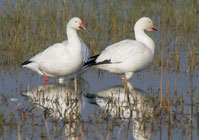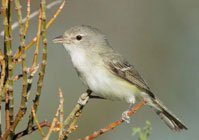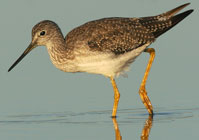Accomplishments
The CVJV partnership has earned an impressive record of accomplishment since its inception in 1988, and is making great progress towards meeting the objectives identified in its 2020 Implementation Plan.

 Bell’s Vireo
Bell’s VireoThere have been many great projects that the Central Valley Joint Venture (CVJV) has undertaken in its 25 year history. Our first, and perhaps most exciting, major project was the Llano Seco acquisition. Llano Seco, originally known as the Parrot Ranch project, was a multi-agency, multi-partner project that resulted in 18,000 acres of vital habitat going into protection for the benefit of birds and wildlife. It was a key acquisition for the Sacramento National Wildlife Refuge Complex as well as the California Department of Fish and Game, and The Nature Conservancy. It established the CVJV as a key player in Central Valley habitat protection efforts.
Historically, Rancho Llano Seco was part of a Mexican land grant in present day Butte County. It was given by Governor Pio Pico to Sebastian Keyser in 1845. Llano Seco means “dry plains” in Spanish. The grant extended along the east bank of the Sacramento River south of present day Chico. Between 1860 and 1875, John Parrott acquired all of Rancho Llano Seco. Over the years, the land was passed down through generations of the Parrott family. It was that connection to the landscape and family history that made Tim Parrott adamant that the property be protected when the time came to negotiate the long-term protection of the property for the benefit of the various wildlife species and associated habitat.
The Llano Seco project was accomplished in phases, as financial support became available. The U.S. Fish & Wildlife Service (USFWS), Wildlife Conservation Board, The Nature Conservancy (TNC) and Tim Parrot made substantial contributions, with TNC playing a central role in finding the funding. At a time when collaboration and trust amongst diverse partners was rare, committed individuals came together and accomplished a very complicated transaction, leaving a considerable, and irreplaceable, natural legacy for all Californians.
At the time of the acquisition, the CVJV was in its infancy. Dave Paullin was the Joint Venture Coordinator, and the first Central Valley Habitat Joint Venture Implementation Plan had just been signed. Gary Kramer was the Project Leader at the Sacramento National Wildlife Refuge Complex, and as the prior CVJV Coordinator, he also clearly understood the value of these partnerships. Dave Paullin and other CVJV partners acted as behind-the-scenes facilitators for the project, working to make sure that the acquisition was integrated into the habitat objectives of the Implementation Plan, and lend organizational support. The Llano Seco Project was a very coordinated effort that put the stamp of validity on the Joint Venture - and showed what a partnership could do.
The Llano Seco Project was also the beginning of a very successful collaboration with the USFWS Sacramento Realty Office, one that would find the two entities working closely together to insure that the Realty Office’s priorities were aligned with the long term vision and habitat objectives of the CVJV. According to Steve Dyer, Realty Chief for the USFWS Pacific Southwest Region, the success of the CVJV “spread across the country. The National Joint Venture concept was new, but it became more influential with the implementation of successful partnership projects like this. Their funding and sphere of influence started with regional Implementation Plans and gained momentum, ultimately causing a shift in approaches to conservation.”
In the years since the successful Llano Seco acquisition, joint ventures have become the gold standard. They are now widely accepted as the model for collaborative conservation in the 21st century. They use state-of-the-art science to ensure that a diversity of habitats is available to sustain migratory bird populations for the benefit of those species, other wildlife, and the public. The CVJV can be very proud of the fact that they provided the model for other joint ventures and helped give birth to a collaborative approach to bird conservation.
The CVJV partnership has earned an impressive record of accomplishment since its inception in 1988, and is making great progress towards meeting the objectives identified in its 2020 Implementation Plan.

Follow these links to learn about some of the important bird conservation work happening in California's Central Valley.
